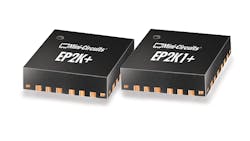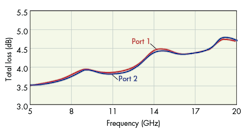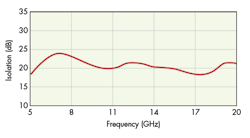This file type includes high resolution graphics and schematics when applicable.
Distribution of RF/microwave signals throughout high-frequency circuits and systems relies heavily on power splitters/combiners. As modern design trends shrink passive components like power splitters/combiners to ever-smaller sizes, a major challenge confronts designers: How does one manage reasonable levels of signal power without suffering the consequences of difficult-to-dissipate heat within a circuit or system design?
To address that issue, Mini-Circuits developed a new series of true surface-mount-technology (SMT) power splitters/combiners that provide outstanding electrical performance over a wide bandwidth covering a frequency range of 2.0 to 26.5 GHz. Power-handling capabilities extend to 2.5-W continuous-wave (CW) power and beyond in QFN packages measuring a mere 4 × 4 × 1 mm.
The new power splitter/combiner series includes the 5- to 20-GHz model EP2K+ and the 2.0- to 26.5-GHz model EP2K1+, both two-way, 0-deg. dividers/combiners based on GaAs integrated-passive-device (IPD) technology (Fig. 1). They can be used to combine two input signals into one output signal, or divide an input signal into two output signals, with 0-deg. phase difference between the two output signals (when multiple versions of the same signal are needed).
Traditionally, power splitters/combiners are fairly large components in microwave printed-circuit boards (PCBs) and systems, with coaxial connectors or even waveguide flanges used for connection to other components in a system. The larger size will typically bring higher power-handling capabilities with it, but often the power combining or dividing function may be required for lower-level rather than high-power signals. Surface-mount components provide the flexibility to add those functions almost anywhere on a PCB.
Size Reduction via GaAs IPD
One proven approach for shrinking the size of passive components, including power splitters/combiners, is to fabricate passive circuits using semiconductor substrate materials and processes. GaAs IPD technology, which employs GaAs substrates with multiple layers of metallization, has proven quite effective for realizing compact passive circuitry with excellent high-frequency performance. Mini-Circuits’ new devices employ GaAs monolithic-microwave-integrated-circuit (MMIC) technology to fabricate the small die required to fit within the miniature surface-mount packages.
Surface-mount power splitters/combiners are not new for Mini-Circuits. The firm offers many different configurations of these and other types of active and passive components, including an earlier power splitter/combiner model in the “EP” product family with extremely broad frequency range that’s also packed into a 4- × 4- × 1-mm SMT housing. This earlier device—the 0-deg., two-way model EP2C+—offers excellent performance over a wide bandwidth ranging from 1.8 to 12.5 GHz, but nowhere near approaching the upper-frequency limits and bandwidths of the two latest EP family members.
Depending on the frequency coverage required, all three power splitters/combiners are designed for reliable thermal management, capable of relatively high levels of internal power dissipation and tested to handle input-power levels as high as 2.5 W CW when used as power dividers. The EP line of power splitters/combiners are also built to last under less-than-ideal operating conditions, featuring operating-temperature ranges of –40 to +85°C and high levels of electrostatic-discharge (ESD) protection.
5- to 20-GHz Model Specs
The lower-frequency model of the new SMT power divider/combiner pair, the 5-to-20-GHz EP2K+, exhibits typical insertion loss of 1.1 dB from 5 to 10 GHz; 1.7 dB from 10 to 18 GHz; and 2.1 dB from 18 to 20 GHz (Fig. 2). It achieves typical isolation of 22 dB from 5 to 10 GHz; 20 dB from 10 to 18 GHz; and 20 dB from 18 to 20 GHz (Fig. 3).
This tiny MMIC splitter/combiner maintains tight control of amplitude and phase characteristics across its wide frequency range. The specified amplitude unbalance is typically within 0.1 dB across the full frequency range, with worse-case performance within 0.5 dB across the full frequency range. Phase unbalance is typically within 2.3 deg. from 5 to 10 GHz; 3.7 deg. from 10 to 18 GHz; and 4.2 deg. from 18 to 20 GHz. The VSWR is typically 1.40:1 or better at all ports through 18 GHz, and typically better than 1.50:1 at all ports through 20 GHz.
2- to 26.5-GHz Model Specs
The higher-frequency member of the new series, the EP2K1+, operates from 2 to 26.5 GHz and actually provides usable performance (in terms of low loss and VSWR and high isolation) from 1.8 to 28.0 GHz. The two-way 0-deg. power divider/combiner achieves typical insertion loss of 0.8 dB from 2 to 5 GHz, 1.1 dB from 5 to 10 GHz, 1.7 dB from 10 to 18 GHz, and 2.4 dB from 18 to 26.5 GHz. It provides typical isolation of 14 dB from 2 to 5 GHz, 22 dB from 5 to 10 GHz, 20 dB from 10 to 18 GHz, and 21 dB from 18 to 26.5 GHz.
As with the lower-frequency model EP2K+, the EP2K1+ is fabricated with a tightly controlled GaAs MMIC process that results in outstanding amplitude and phase balance. Typical amplitude unbalance is 0.1 dB from 2 to 5 GHz; 0.1 dB from 5 to 10 GHz; 0.1 dB from 10 to 18 GHz; and 0.3 dB from 18 to 26.5 GHz. Typical phase unbalance is 1.5 deg. from 2 to 5 GHz; 2.3 deg. from 5 to 10 GHz; 3.7 deg. from 10 to 18 GHz; and 5.4 deg. from 18 to 26.5 GHz. The EP2K1+ exhibits VSWR at all ports, which is typically 1.50:1 or better at the lowest and highest frequencies (2 to 5 GHz and 18.0 to 26.5 GHz) and 1.40:1 or better at all other frequencies.
The small size and broad bandwidths of these RoHS-compliant power splitters/combiners suits them for a wide range of applications in WiMAX, Industrial-Scientific-Medical (ISM), test-and-measurement, radar, electronic-warfare (EW), and satellite-communications (satcom) circuits and systems. Both can pass as much as 0.2-A current for applications, such as antennas, that might require passing dc current along with RF/microwave signals. The devices are lead-free and RoHS-compliant, and can be supplied on tape-and-reel packaging for use with automated production equipment.
Mini-Circuits, P. O. Box 350166, Brooklyn, NY 11235-0003; (718) 934-4500, FAX: (718) 332-4661.
About the Author
Jack Browne
Technical Contributor
Jack Browne, Technical Contributor, has worked in technical publishing for over 30 years. He managed the content and production of three technical journals while at the American Institute of Physics, including Medical Physics and the Journal of Vacuum Science & Technology. He has been a Publisher and Editor for Penton Media, started the firm’s Wireless Symposium & Exhibition trade show in 1993, and currently serves as Technical Contributor for that company's Microwaves & RF magazine. Browne, who holds a BS in Mathematics from City College of New York and BA degrees in English and Philosophy from Fordham University, is a member of the IEEE.




